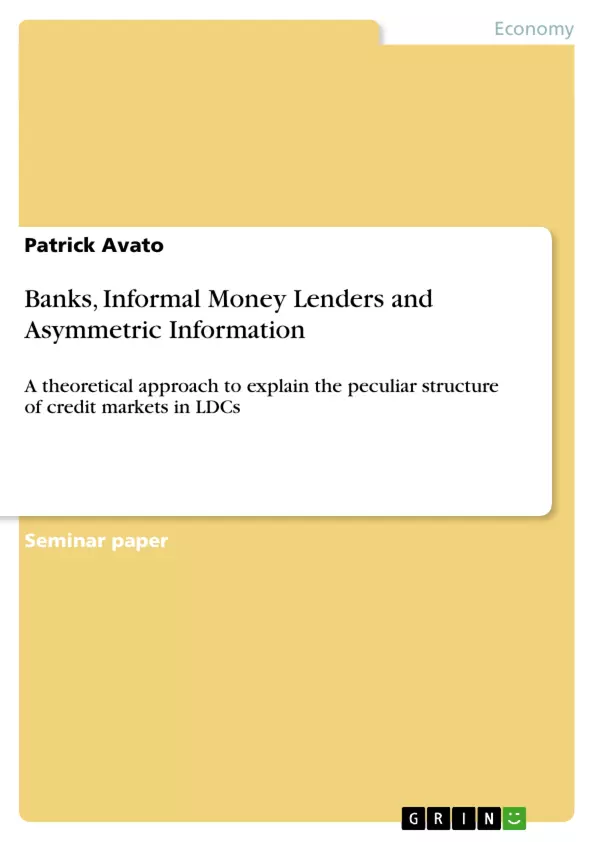Credit markets in developing countries differ substantially from their counterparts in OECD countries. Apart from the obvious differences in institutional development, technology and productivity which are both measures for and causes of underdevelopment, typ ical LDC credit markets have two main characteristics. Firstly, their financial systems are very small compared those in industrial economies. Secondly, developing countries are characterized by very big informal financial sectors that coexist with formal credit institutions. Interestingly, credit contracts differ highly between these two sectors and there seems to be only very limited inter-sector competition. The following paper ventures to explain the persistence of these peculiarities in rural credit markets1 using the model of asymmetric information in credit markets developed by Stiglitz and Weiss. By applying the model specifically to LDC credit markets I show that asymmetric information is among the major reasons for the underdevelopment of rural credit markets. Building on these findings I then explain how Microfinance Institutions (MFI) have lately been able to overcome some of the problems of imperfect information and strive in markets formerly dominated by informal money lenders.
The first part of this paper provides an overview of the typical characteristics of credit markets in developing countries, concentrating on the limited size of LDC credit markets and on the apparent dichotomy between formal and informal finance sectors. Then, the importance of financial systems for economic development is briefly outlined in order to explain the relevance of the topic of this essay. The main part of the paper then presents the model of asymmetric information in credit markets pioneered by Stiglitz/Weiss as a possible explanation for the causal origins of these characteristics. The last part shows how successful microfinance institutions may succeed in operating in rural credit markets by their ability to overcome problems of imperfect information.
Inhaltsverzeichnis (Table of Contents)
- I. Introduction.
- 2. Credit Markets in Developing Countries
- 2.1. Empirical Findings
- 2.1.1. The Size of Credit Markets
- 2.1.2. Informal Credit Markets..
- 2.2. Financial Markets and Development..
- 2.1. Empirical Findings
- 3. The Asymmetric Information Paradigm
- 3.1. The Stiglitz/Weiss Model
- 3.2. Application of the model to rural markets
- 4. Microfinance
- 5. Conclusion…….......
Zielsetzung und Themenschwerpunkte (Objectives and Key Themes)
This paper investigates the unique characteristics of credit markets in developing countries, specifically focusing on the limited size of the financial system and the significant role of informal credit markets. By applying the model of asymmetric information developed by Stiglitz and Weiss, the paper aims to explain the underdevelopment of rural credit markets in LDCs. It also explores how Microfinance Institutions (MFI) are effectively tackling information imperfections and thriving in markets previously dominated by informal lenders.
- Characteristics of credit markets in developing countries
- Role of asymmetric information in rural credit markets
- Limited size of formal credit markets in LDCs
- Presence of informal credit markets in developing countries
- Impact of Microfinance Institutions on credit markets
Zusammenfassung der Kapitel (Chapter Summaries)
The first chapter provides an overview of credit markets in developing countries, highlighting the limited size of the financial system and the significant role of informal credit markets. It also discusses the importance of financial systems for economic development. The second chapter delves into the asymmetric information paradigm, explaining the Stiglitz/Weiss model and its applicability to rural credit markets. The final chapter examines the role of Microfinance Institutions in addressing information imperfections and improving access to credit in rural areas.
Schlüsselwörter (Keywords)
The paper focuses on credit markets in developing countries, asymmetric information, rural credit markets, informal credit markets, Microfinance Institutions (MFI), financial development, and the Stiglitz/Weiss model.
- Citation du texte
- Patrick Avato (Auteur), 2005, Banks, Informal Money Lenders and Asymmetric Information , Munich, GRIN Verlag, https://www.grin.com/document/40080



